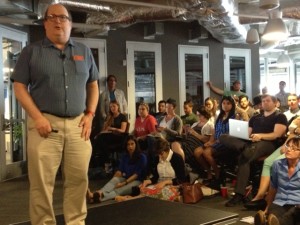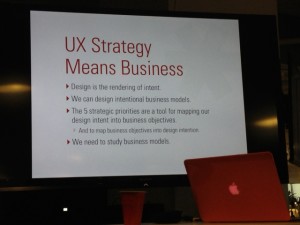UX Specialist Jared Spool Shares High-Impact Insights @ProductAustin

Who knew that a UX specialist would know so much about the value of great content?
I learned Tuesday night that software developer and programmer, Jared Spool, holds great content in high regard. He is CEO and founding principal of User Interface Engineering.
Throughout his in-depth, fascinating, and funny talk at the Product Austin Meetup at Capital Factory this month, he stated that, while great design is important, quality content is paramount to great user experiences. “Without good stories, good design is not useful,” Spool stated.
To create online businesses that generate revenue, he added business strategy to the equation. “Creating useful and delightful content must be the primary consideration, with a thoughtful business model that generates revenue from the content.”
Spool shared multiple examples of when content + design + business strategy works and when it doesn’t.
For example, when The New York Times put its content behind a pay wall, few thought it would work. But it worked. In fact, it was so successful that the NYT generated more revenue from the pay wall than from ads. It found that loyal customers were willing to pay to read its content online and new customers wanted access, as well (after reading 10 articles for free). New customers also wanted the print edition.
The NYT content consumption strategy was so successful that other media outlets have adopted it as well, like the Financial Times and The Boston Globe.
“You can only pull that off with excellent content,” noted Spool.
Seducible Moments — Where the Magic Happens
What the NYT achieved, according to Spool, is the Holy Grail of content business strategy — a “seducible moment.” Unlike advertising, which disrupts users from the content they want with content they don’t want, seducible moments happen when users are engaged in free content that is meaningful to them. As a result, they are more likely to purchase related content, products, and services.
To create seducible moments, Spool said that companies must build their business strategy into their consumption model, starting with a delightful user experience on one end and generating profit on the other. In the middle is the business model you choose to move the company from point 1 to point 3.
“Today everyone wants to be in the content distribution business. There are many options where it works for both the companies and the users.”
Spool described several content-driven business models, adding, “These are only a sample of the many strategic options available.”
- Supporting Product Sales — upselling lessons, tools, and supplies (like Etsy and IFixIt).
- In-App Purchases — offering additional functionality that expands the overall functionality “one little purchase at a time.”
- Repurposed Content — turning web content into books, CDs, courses, and more that users can purchase (like GrammarGirl.com).
- Alternative Channel Revenue — providing the content users want in a different format for a fee (like RadioLab).
How Crutchfield Crushed Walmart
Spool ended his talk with a case study that illustrates his main point. In a study conducted at his research lab, researchers compared user experiences on two companies’ websites: Walmart and Crutchfield. They gave each user the same amount of money to purchase a camera on the site. Then they watched them engage in their ecommerce experience.
Walmart’s camera pages contained only content that was cut and pasted from the manufacturers’ product information, just like most online camera sites.
At Crutchfield, content is very different. The company hires support personnel who are passionate about cameras to write all of the content they desire. This includes long and detailed descriptions of each piece of equipment, in-depth product research reports, comparison charts, photographs, videos, and more.
The result of the study:
• At the Walmart site, the users spent 89% of the money they were given to buy a camera (they were allowed to keep any money they didn’t spend).
• At the Crutchfield site, users spent 237% — 137% out of their own pocket for product upgrades and accessories.
The only different between the two sites, said Spool: “Content.”

Ivan says
Nice article and good example in the Walmart vs. Crutchfield article. My old business http://www.videocityguide.com was based on a content model and I know the value of good content for engagement, SEO, and sales. May have to revisit that brand again one day. Thanks for the share.